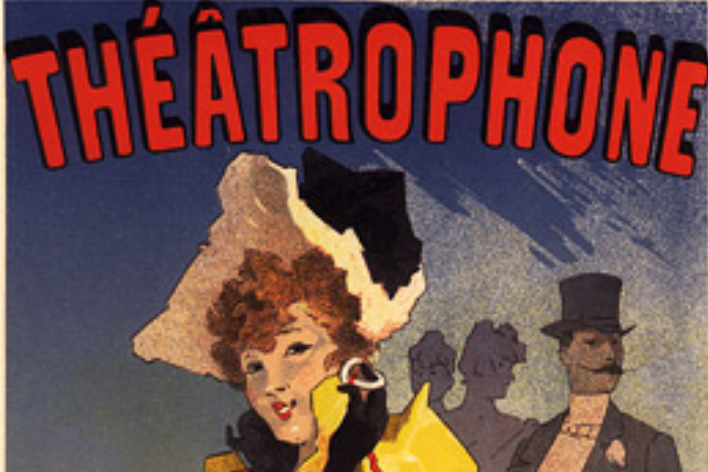We’ve long taken the ability to summon up audio entertainment on demand, be it through radio, CDs, tapes, and records, or via the internet. But the first method of transmitting audio into private homes has been completely forgotten.

Long before voices and music were transmitted through the air — and even before people owned phonographs and records — the well-to-do in cities like Paris, Lisbon, Brussels, Stockholm, London, and even New York were able to listen to music and theatre productions without having to go anywhere. And in stereo, too.
Clement Adler, a French inventor, dazzled the crowds at the International Electricity Exhibition, part of the 1881 Paris World Expo, when he unveiled the Théâtrophone.
Using brand-new telephone technology, he set up 80 transmitters — the carbon microphones from telephones — across the front of the stage of the Paris Opera. Forty were directed at the left side of the stage and another forty to the right. The result was two channels of audio that created a stereophonic image (a “binauralicular audition”) of the performance.
Wires were then run through the Parisian sewers from the theatre to the exhibition space two kilometres away where 20 receiving units were set up. Three nights a week, between 8 and 11 p.m., Adler allowed people to listen in to what was happening on stage using two earpieces, which functioned as a proto-headphones. (Like the term “stereo,” the invention of headphones was still a couple of decades away.)
The result was a reasonably accurate sonic representation of what the audience in the theatre heard. La Revenue Scientifique wrote that Adler’s “telephone receivers … allowed for the singing, the words, and the orchestral melodies to be heard with a remarkable clarity.”
WATCH BELOW: Making Waves — A history of the radio

Decades before cable TV, Adler provided Parisians with what was essentially cable radio. It was also the 19th century equivalent of today’s live stream. Among the first to experience the new technology in November of that year was Victor Hugo, who pronounced it “pleasant.”
Other nations lined up to get on board with the new technology: Belgium (1884), Portugal (1885), Sweden (1887), Budapest (1893) and London (1895). There were even experiments in New York with broadcasts from Madison Square Garden. King Luis of Portugal was so impressed by his installation that he awarded the company the Military Order of Christ, an honour with a history dating back to the Knights Templar in the 14th century.
Adler continued demonstrations through the end of 1889 at the foot of the recently-constructed Effiel Tower. By 1890, the Compagnie du Théâtrophone was in business, attracting customers at a furious rate.
READ MORE: Why companies are buying up the rights to thousands of songs, Alan Cross says
“Paris citizens will shortly be able, by dropping a half-franc piece into a slot, to hear a play or a concert,” said a note in the Electrical Review dated June 21, 1890.
“(Compagnie du Théâtrophone founders) Marinovitch and Szaravady have devised an apparatus for this purpose, which they have named the ‘Theatrephone,’ and they propose to introduce it into clubs and hotels. An experiment was made in Paris the other day, and was pronounced a very successful one.”
Connecting was a bit clunky. First, you needed a telephone line — not a given thing in the late 1800s. You connected to an operator at the central Théâtrophone station, who then connected you to the audio feed from any number of theatres in the system.
And it was definitely very successful. Coin-operated units — essentially, dedicated telephone receivers that looked like tall lunchboxes — were installed in private clubs, cafes, and hotels. Programming consisted of music and regular five-minute newscasts. That half-franc (50 centimes) got you 10 minutes of listening. Regular users could buy subscriptions that allowed for listening at a discounted rate.
The monied folk did get on board with Théâtrophone subscriptions in the same way we subscribe to a cable/satellite package or streaming music services. The writer Marcel Proust thought it was worth having a system installed in his home, given his poor health and his reluctance to go out. It wasn’t cheap — 60 francs per month (equivalent to over $300 today) — but many thought the entertainment value was worth it.

Some referred to the new devices as a “pleasure telephones.” Others derided the pastime as a technological distraction for the upper classes. It was also a great status symbol. In 1892, the Lord Mayor of London was able to offer his guests the ability to listen to the Paris Opera from the U.K.
Users tended to be music lovers, so they unsurprisingly kept demanding for better audio quality. A new application technology called the Brown relay appeared in 1910, greatly boosting the signal.
Meanwhile, wireless radio experiments by Guglielmo Marconi, Lee DeForest, and others were stifled by the outbreak of the Great War. Radio was considered to be too important to be left in the hands of civilians, so private commercial use of the medium was banned until almost 1920. That allowed Théâtrophone systems to survive and, in fact, thrive.
But with the rise of phonographs, gramophones, the recorded music industry, and over-the-air radio, Théâtrophone technology was doomed. The company finally called it quits in 1932.
—
Alan Cross is a broadcaster with Q107 and 102.1 the Edge and a commentator for Global News.
Subscribe to Alan’s Ongoing History of New Music Podcast now on Apple Podcast or Google Play






Comments